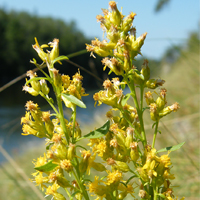Pale Showy Goldenrod
Scientific name: Solidago pallida

Photo credit: Jane M. Bowles
Status
Threatened
“Threatened” means the species lives in the wild in Ontario, is not endangered, but is likely to become endangered if steps are not taken to address factors threatening it.
Date added to the Species at Risk in Ontario List
June 8, 2011
On January 26, 2022, the common and scientific names of this species were updated on the Species at Risk in Ontario List from Showy Goldenrod (Boreal population) (Solidago speciosa) to Pale Showy Goldenrod (Solidago pallida) to be consistent with recent diagnostic and taxonomic changes. The species’ name change does not change the previous protections afforded to the species under the Endangered Species Act, 2007 or the applicability of any policies, permits and agreements, guidance documents or best management practices that may have been published or issued by the Government of Ontario in respect of the species.
What it looks like
Pale Showy Goldenrod is a large perennial belonging to the aster family. It can grow to two metres in height. It has large, toothed, egg-shaped lower leaves and much smaller more smooth-edged upper leaves.
Pale Showy Goldenrod typically has numerous upright, unbranched stems rising from a central clump. The small yellow flowers form a cylindrical cluster along the upper 30 cm of the stem.
Where it lives
In northwestern Ontario, Pale Showy Goldenrod grows in prairie grassland on south-facing slopes, on shallow soils over bedrock, bordered by jack pine and white pine.
Here, the habitat remains in an open condition due to the shallowness of the soil, which is not deep enough for trees and shrubs to become established.
Where it’s been found in Ontario
Currently, there is a single population of Pale Showy Goldenrod in northwestern Ontario. This single population contains approximately 1000 plants.
What threatens it
The main threat to Pale Showy Goldenrod is habitat destruction due to development together with agricultural expansion.
Other threats include damage to plants from pedestrian and ATV traffic, and competition from invasive plants.
Action we are taking
Threatened species and their habitat are protected.
Recovery strategy
A recovery strategy advises the ministry on ways to ensure healthy numbers of the species return to Ontario.
Read the executive summary (August 13, 2014)
Read the recovery strategy (August 13, 2014)
Government response statement
A government response statement outlines the actions the government intends to take or support to help recover the species.
Read the government response statement (May 13, 2015)
Review of Progress
A review of progress made toward protecting and recovering a species is required no later than the time specified in the species’ government response statement, or not later than five years after the government response statement is published if no time is specified.
Read the report on progress towards the protection and recovery of four species at risk, including Pale Showy Goldenrod (under its former name of Showy Goldenrod – Boreal population) (2020).
Habitat protection
General Habitat Protection - June 8, 2011
What you can do
Report a sighting
Submit your observations of species at risk to the Natural Heritage Information Centre (NHIC), which is Ontario’s conservation data centre. Join the “(NHIC) Rare Species of Ontario” project in iNaturalist to make submitting your observations quick and easy.
Volunteer
Volunteer with species at risk programs, such as community science surveys, through your local nature club, a provincial park or other conservation organizations.
Be a good steward
- Individuals, communities and organizations across the province who undertake stewardship or research activities that benefit species at risk and their habitats may be eligible to receive funding through the Species at Risk Stewardship Program (SARSP). The SARSP was created to encourage people to get involved in protecting and recovering species at risk in Ontario through stewardship actions.
- Invasive species seriously threaten many of Ontario’s species at risk. To learn what you can do to help reduce the threat of invasive species, visit:
- Pale Showy Goldenrod and many other species at risk depend on healthy grassland prairies, a rare habitat in Ontario. Learn more about these habitats, the species that depend on them, and what you can do to help at:
- Pollinators, such as bees, are in steep decline across the globe and they play a key role in the survival of many of Ontario’s rare plants. For information on how you can help scientists monitor pollinator populations in Ontario visit:
Report illegal activity
Report any illegal activity related to species at risk to
Quick facts
- The population of Pale Showy Goldenrod in northwest Ontario does not seem to belong to any known variety of the plant, two to four of which are recognized. It may be a new variety endemic to Ontario and possibly nearby Manitoba.